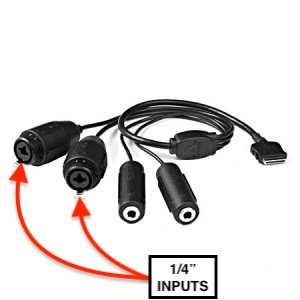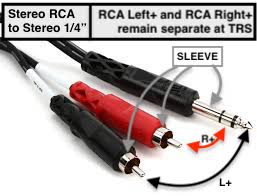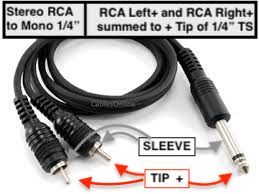Hello. I am new to the forum and new to tape recording, too. In fact, I just purchased a Portastudio 414 MK II and am waiting for it to arrive. I will mostly fiddle around with it to make demos on its own, but once I have the basics figured out I want to know how best to connect this to my computer. I use an Apogee Duet as an interface through Garage Band (I know there are far better DAWs out there, but I am still very green when it comes to recording and Garage Band has worked ok for the basic needs I've had so far). So, my questions are:
- What is the best sort of cable that would connect the 414's outputs to the 1/4 inch jack on the Duet? I believe the outputs on the recorder are balanced RCA jacks, so I am assuming I just need a basic converter cable. Is that correct?
- Is the above question the wrong way to go about it? Is there a better way to send a signal from the 414 to a device like the Duet?
- In the event I wanted to connect the 414 directly to a computer, are there cables that would do so through a mini jack or USB?
- I am so new to this I don't even know if there is any particular cassette tape that works best with a 414. Is there any "standard" tape I should look for?
Any advice greatly appreciated.
Thank you.
Comments
Kurt Foster, post: 463447, member: 7836 wrote: 1. rca jacks are
Kurt Foster, post: 463447, member: 7836 wrote: 1. rca jacks are not balanced.
2. all porta studios use chrome type II tape.
3. the porta studio is analog so there is no USB out.
4. take a Hosa rca to 1/4" cable from the porta studio to the interface or a rca to 1/8" mini jack directly into the computer. i would expect the interface way would give you better audio.
5. you can get the cables on Amazon.
Thank you. Very helpful. I’m aware that the recorder wouldn’t have USB but was curious if there is any sort of adaptor cable that would go from those outputs to a USB.
Kurt Foster, post: 463447, member: 7836 wrote: 4. take a Hosa rc
Kurt Foster, post: 463447, member: 7836 wrote: 4. take a Hosa rca to 1/4" cable from the porta studio to the interface
Kurt has given you the best way to make the connections. The Line Outs and Mon Outs of the Tascam are RCA, so you'd need RCA to 1/4" TS cables to go into the Apogee's I/O breakout cable. *Note that they would plug into the Neutrik XLR/TRS Combi Input Jacks, NOT the 1/4 connectors. (shown below)
To honest, I'm not sure how much capability, quality, or character you'll be adding by inserting something like the Portastudio into your Duet set up - especially if you're just making demos on your own, but I hope it works out the way you want it to.
Best of luck. Let us know how it goes.
dvdhawk, post: 463449, member: 36047 wrote: Kurt has given you t
dvdhawk, post: 463449, member: 36047 wrote: Kurt has given you the best way to make the connections. The Line Outs and Mon Outs of the Tascam are RCA, so you'd need RCA to 1/4" TS cables to go into the Apogee's I/O breakout cable. *Note that they would plug into the Neutrik XLR/TRS Combi Input Jacks, NOT the 1/4 connectors. (shown below)
To honest, I'm not sure how much capability, quality, or character you'll be adding by inserting something like the Portastudio into your Duet set up - especially if you're just making demos on your own, but I hope it works out the way you want it to.
Best of luck. Let us know how it goes.
Thanks much. Mostly, I am trying to figure out how I would digitize whatever I end up recording on the Portastudio.
If your plan is to go digital in the computer, then why involve
If your plan is to go digital in the computer, then why involve the portastudio at all? Plenty of people love analogue for whatever reason, but they don't seem to find feeding what they recorded into a computer that useful, apart from getting it onto streaming services at the end?
paulears, post: 463456, member: 47782 wrote: If your plan is to
paulears, post: 463456, member: 47782 wrote: If your plan is to go digital in the computer, then why involve the portastudio at all? Plenty of people love analogue for whatever reason, but they don't seem to find feeding what they recorded into a computer that useful, apart from getting it onto streaming services at the end?
That is indeed the end goal. Not necessarily for streaming, but to be able to share the music in a way that most people hear it these days. Maybe I'm missing something, but how else would I get it from the tape to other listeners? What interests me about the recorder is the process, a desire to be able to just sit down and play and tape stuff and not have to worry about the computer at all in the moment.
dvdhawk, post: 463449, member: 36047 wrote: Kurt has given you t
dvdhawk, post: 463449, member: 36047 wrote: Kurt has given you the best way to make the connections. The Line Outs and Mon Outs of the Tascam are RCA, so you'd need RCA to 1/4" TS cables to go into the Apogee's I/O breakout cable. *Note that they would plug into the Neutrik XLR/TRS Combi Input Jacks, NOT the 1/4 connectors. (shown below)
To honest, I'm not sure how much capability, quality, or character you'll be adding by inserting something like the Portastudio into your Duet set up - especially if you're just making demos on your own, but I hope it works out the way you want it to.
Best of luck. Let us know how it goes.
Thanks again for this (the diagram is very helpful :)). Looking online I see there are RCA to 1/4 cables that would allow me to plug in both RCA signals individually or cables that take the two RCA and blend them into on 1/4 plug. I am assuming the former -- two plugs on each end -- would be better to go into the Duet? So, a cable like this should do the trick? https://www.amazon…
Most people use analogue for that elusive ‘sound’ but if they al
Most people use analogue for that elusive ‘sound’ but if they already need to get audio into a computer for distribution then nowadays it’s actually simpler to use the same software to record and mix, but it’s a choice. For me, better eq, nice reverbs and proper stereo mean I won’t ever go back to analogue and track bouncing
Yes, those cables would do nicely. If you were to use a Y-cable
Yes, those cables would do nicely.
If you were to use a Y-cable and 'blend' the Left and Right channels, the resulting audio would be mono. There's a time and place for Y-cables, but I don't think this is it for your application. If you DO decide to get dual RCA to 1/4" Y-cables, make sure that the 1/4" male is 2-conductor TS. If you got the kind that goes to 3-conductor TRS any number of bad things might happen. For your application on the TS (Mono) 1/4" would be useful.
paulears, post: 463460, member: 47782 wrote: Most people use ana
paulears, post: 463460, member: 47782 wrote: Most people use analogue for that elusive ‘sound’ but if they already need to get audio into a computer for distribution then nowadays it’s actually simpler to use the same software to record and mix, but it’s a choice. For me, better eq, nice reverbs and proper stereo mean I won’t ever go back to analogue and track bouncing
Yep, that all makes sense. Thanks for the input.
dvdhawk, post: 463461, member: 36047 wrote: Yes, those cables wo
dvdhawk, post: 463461, member: 36047 wrote: Yes, those cables would do nicely.
If you were to use a Y-cable and 'blend' the Left and Right channels, the resulting audio would be mono. There's a time and place for Y-cables, but I don't think this is it for your application. If you DO decide to get dual RCA to 1/4" Y-cables, make sure that the 1/4" male is 2-conductor TS. If you got the kind that goes to 3-conductor TRS any number of bad things might happen. For your application on the TS (Mono) 1/4" would be useful.
Very good to know. Thank you.
Riachuelo, post: 463457, member: 51851 wrote: That is indeed the
Riachuelo, post: 463457, member: 51851 wrote: That is indeed the end goal. Not necessarily for streaming, but to be able to share the music in a way that most people hear it these days. Maybe I'm missing something, but how else would I get it from the tape to other listeners? What interests me about the recorder is the process, a desire to be able to just sit down and play and tape stuff and not have to worry about the computer at all in the moment.
imo as long as you're playing it's all good. porta studios are a bit challenged as far as frequency response and dynamic range but in the right hands with the right song and performances there no reason a great record can't be recorded. a lot of artists have recorded mega hit records on porta studios, 1/4" rtr's and even Boss type digital "studios" (and not just Nebraska).
the idea that "proper stereo", e.q's and reverbs and editing tools in a modern DAW alone make for better productions is (again imo) a red herring. mono can sound great! sometimes collapsing / bouncing tracks makes them sound better (just ask Kieth Richards). sometimes limitations force creativity or (even better) require a lot of talent be present in the room all at the same time. flip side / too many options can stifle progression. sure you can do anything with a key stroke ... but so can anyone else.
too many options can overwhelm a production. i've seen people struggle for months to achieve what was done in the 50's in 3 hours and still never quite "get it". some go to great lengths in DAW world to create rooms they don't have or degrade the sound to make recordings sound like the 60's & 70's or to "glue things together". if that works for some i say great, but not for me.







1. rca jacks are not balanced. 2. all porta studios use chrome t
1. rca jacks are not balanced.
2. all porta studios use chrome type II tape.
3. the porta studio is analog so there is no USB out.
4. take a Hosa rca to 1/4" cable from the porta studio to the interface or a rca to 1/8" mini jack directly into the computer. i would expect the interface way would give you better audio.
5. you can get the cables on Amazon.